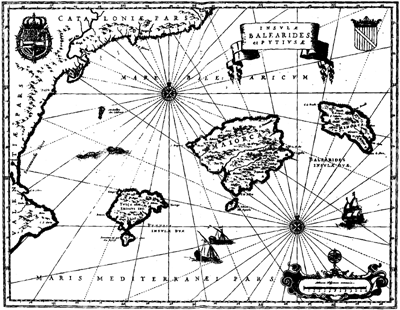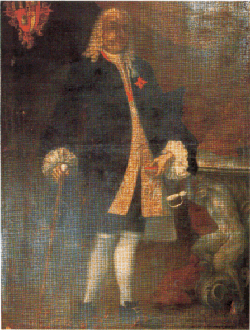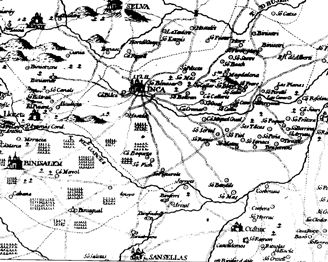XVII and XVIII centuries

"Insulae Balearides et Pytiusae" Grabado (1663).
Dn. Roderic Bordils Morey, owner of the property in the late sixteenth century, married Ms. Isabel de Berga i Maixella. The couple had four children: Roderic, who died young, Jaume Joan, who had no children, Joana i Jeronia. Jeronia Bordils i Berga married Dn. Tomas Bordils i Nadal, who belonged to the family line founded by Dn. Bordils i Joan d'Olesa, who died in 1517, owner of Albarca. Bordils i Nadal Tomas died in 1634, having been 'jurat', 'minister', 'mostassà' and 'General batle'.
His son, Dan. Joan of Bordils-Morei i de Berga, also referred to as Dn. Joan i Bordils Bordils (Pascual, A. in "La Casa and Time", 1999), who died in 1667, was captain of the town of Sóller and "jurat major" of the kingdom by the establishment of the "Military Citizens "(1664). In 1647, the owner of Son Bordils, had married Ms. Magdalena Truyols and Sureda-Zanglada, so the family took up residence in the house of Can Sureda-Zanglada, formerly called Casa de l'Almudaina, that from that time spent taking the name of Can Bordils; now houses the Municipal Archive of Palma
Meanwhile, 'in 1652 a terrible plague struck the island being our city (Inca) one of the most attacked. Seven houses were inhabited, people fled their homes field work, the Thursday market held stopped several years. (sic). Soon contagion became general and in the few months that lasted more than 20,000 casualties made throughout the island, the most attacked the capital and Inca, who suffered 2725 casualties, ie more than half of its population. This disaster completely paralyzed life in Inca '. It seems obvious that a health disaster of this size very significantly affect trade and wine production, the main source of wealth of the hitherto second city of the island, but has also been attributed to the seventeenth century as a century of general crisis. Stang (. Pag 27) explains it as follows: 'King Felipe IV and Mallorca there are years of plague (1652). The number of vineyards was falling throughout the island. Decreases in Alcudia, Inca, Petra, Campos, Felanitx, Porreres, Manacor, Bellver, Montuiri, Binissalem, Arta. It is assumed that the fundamental reason for this decline was the competition that were imported wines from Valencia and Tarragona '.
A Dn. Joan i Bordils Bordils, was succeeded by his son Dan. Joan Baptista de Bordils and Sureda-Sanglada and Truyols, captain of the town of Soller (1705), Knight of the Order of Alcántara, mayor repeatedly and 'jurat in cap' of the town of Palma, a supporter of Philip V in war of Succession (Gran Enciclopedia de Mallorca, Vol. II, page 207 et seq.), as did his brother Frey Miguel de Bordils i Truyols. He remarried with Mrs. Leonor Dameto Nicolau Truyols i Rossinyol, sister of the Marquis de la Torre (Ramis Ayreflor and Sureda, J., Bolletí Luliana the Archaeological Society, 1905).
In the Register of Inca in 1693, has "said M. Possession Son Bordils Bordils Joan Baptista and Sureda Mallorcan Its value 14,000 pounds..
In the File Bordils S. XVIII ground that:
Grace granted by King Carlos Dn Dn second to please. Juan Bautista Burdils to plant 25 quarteradas vineyard on the campus of Son Bordils and land was not suitable for sowing frankly tithe for the first 20 years counting from the day that may plant, out of pay after met this deadline and give security to keep forty years. Given in Aranjuez to May 26, 1700

In 1698, he Testo Dn. Joan Baptista de Bordils and Sureda-Sanglada and Truyols, appointing executors several members of his family and finally died in 1720 without seeing executed the grace of the last king of the Spanish Habsburg dynasty.
He was succeeded by his son, image, Dn. Bordils Juan Sureda-Zanglada Truyols i Dameto, also referred to as Dn. Joan of Bordils i Truiols (Gran Enciclopedia de Mallorca, Vol. II, page 207 et seq.) Or Form as Dn. Joan BPTA. Bordils i Truyols (Pascual, A. in "La Casa and Time", 1999), Knight of the habit of Calatrava, Perpetual Regidor of the city of Palma (1746) until his death (1750) staunch, as his father and uncle, Philip V. bourbon
In 1728 he got the royal pardon was fulfilled, as recorded in the Bordils File:
This grace was sent meet and save by Mayor Dan. Antonio de Otorbegozo by decree of January 12, 1728, given at the foot of the motion of Dn. Don Juan Burdils son, Juan Baptista, à letters were issued through the effect, and the expert witnesses who say abut the ground on the one hand with pine Son Bordils the other way dels Febrers with the other with lands of the heirs of Antonio Ramis, the other with land Bartolome Llompart, second to land Antonio Ferrer, the other with vineyard Francisco Coll, the other with lands Pedro Manuel Gual, the other with lands of the heirs of Pedro Pujol; and on the other with lands of the heirs of Miguel Vallés.
And despu's on 1 June 1728, the same year that John Burdils was forced to maintain that these forty years yield per vine and Surety Dn. Juan Antonio Dureta who took this position, and forced himself?.
(Book of collections of instruments and archive documents and house of Don Juan Bordils and Tamarit. Volume I, Mallorca 1779, p. 689 i 690. Legajo VI, page 42).
In the Register of Inca of 1731, has, "Mr. Don Juan Bautista de Bordils owns among other farms and houses in Inca. Finca Son Bordils call, worth 20,000 pounds married Mallorcan" the illustrious lady Josefa Catalan Tamarit Xammar Vilanova de Elna Copons of Vilafranca Cárcer and Mecca, of the noble House Tamarit, Lords of rodona. And he made his last will on April 25, 1744, instituting usufructuary heir of his estate to his wife and his son owner Juan Bautista. (sic) The said lady his wife survived him 21 years, died, also in Palma, on 10 March 1771 "(Ramis Ayreflor and Sureda, J., Bolletí Luliana the Archaeological Society, 1905). The marriage had had five children. Juan Bautista, last male of the race, Mariana, religious, Salvadora, Magdalena, who married Don Pedro Juan Morell of Pastoritx and Vallés, and Eleanor, who married D. Francisco de Villalonga and Vallés, .. taking marriage two sons: Dan Francesc de Villalonga i Bordils, that by marrying Mrs. Juana climbing López-Salgado, resulted in the Villalonga-Escalada house, and Mrs. Catalina Maria de Villalonga Bordils of Vallés i. Tamarit, who married Dn. Antonio Villalonga Boneo Brondo i Vallés
The heir, Dn. Juan Bautista de Bordils Sureda-Zanglada Tamarit Truyols and Xammar, also referred to as Dn. Joan Baptista de Bordils i Tamarit, was born in Palma, and was poet and military. Among other poems he wrote in Castilian: love object that is celebrated with festive cheers weddings D. Pedro de Verí i Salas, with D. Margarita de Togores i Cotoner (1754). Corps Captain Palma provincial militias and Knight of the Military Order of Calatrava (1780). (Gran Enciclopedia de Mallorca, Vol. II, page 207 ff.).
According Mascaro Pasarius, Inca '... 1784 still had not recovered from the disaster, taking on this date tenth in importance among other villas on the island'. Under the circumstances, '.. the council had to take serious measures to force people back to the city. (sic). In 1784 the production of wine in Inca totaled about 200,000 liters'.
The plane of Mallorca Cardinal Despuig 1785 describes Inca 'Inca is one of the towns that had the Romans and highest in those days than it is in the day, and ancient remains are found among others in the their capos the marble tombstone is engraved. It was inhabited by the Moors. Fairs held every Thursday of the year. Your neighborhood is 778 fires: harvest is azeyte, grains, fruits, almonds, wine and cattle '.

In this second half of the eighteenth century, an agricultural revival occurs; as well as artisanal and industrial. Proof of this are the 46 and 61 linen weavers looms in operation at that time, as well as 4,394 QM wheat produced on average annually during the eighteenth century Inca; the highest average ever recorded. If certain production data recorded in 1784, only 200,000 liters, the area under vines should not exceed the 100-120 Ha.
All this confirms that winemaking in Inca suffered a serious setback with the plague of the late seventeenth century (1652), which had not recovered in the late eighteenth century (1784). The general depression in the region was seen plunged, the disappearance of the "cellars" where vinificaba and traded, population movement into the field, the price of wheat and the existence of very suitable fats land for rice cultivation, had to be key factors in Inca figures vineyard acreage had declined so dramatically.
It should be highlighted here that other wine regions, as Binissalem, apparently not suffered so severely whipping the plague. In 1693 starts in Binissalem planting vineyards on a large scale '(Stang pag 212). Referring to this locality, Mascaro Pasarius (. Mascaro Pasarius, Volume I, page 98) says: 'The XVII, XVIII and XIX centuries were gentler to the villa, and for them the time of its greatest wealth and splendor arrived. Vineyards and wines were famous throughout the island and were the secret impulse that filled the people of huge mansions and raised the parish church ... '. Keep in mind that the land Binissalem are, in general, more stony terms and therefore would be less suitable for cultivation of cereal.

